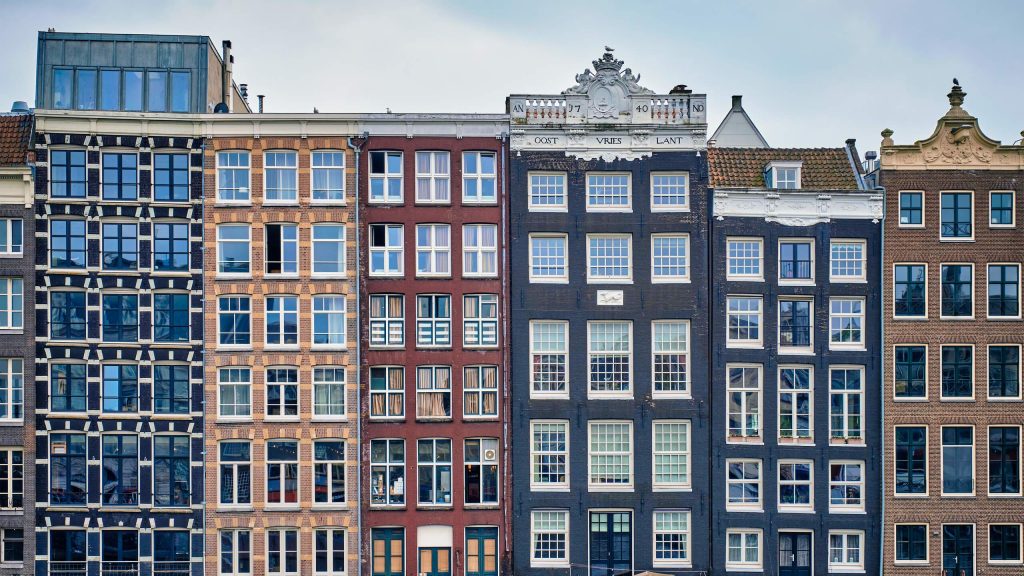Amsterdam is the capital and most populous municipality of the Netherlands. Its status as the capital is mandated by the Constitution of the Netherlands, although it is not the seat of the government, which is The Hague.
Amsterdam has a population of 851,373 within the city proper, 1,351,587 in the urban area, and 2,410,960 in the Amsterdam metropolitan area. The city is located in the province of North Holland in the west of the country but is not its capital, which is Haarlem. The metropolitan area comprises much of the northern part of the Randstad, one of the larger conurbations in Europe, with a population of approximately 8 million.

Amsterdam’s name derives from Amstelredamme, indicative of the city’s origin around a dam in the river Amstel.
Amsterdam’s name derives from Amstelredamme, indicative of the city’s origin around a dam in the river Amstel. Originating as a small fishing village in the late 12th century, Amsterdam became one of the most important ports in the world during the Dutch Golden Age (17th century), a result of its innovative developments in trade. During that time, the city was the leading centre for finance and diamonds. In the 19th and 20th centuries the city expanded, and many new neighbourhoods and suburbs were planned and built. The 17th-century canals of Amsterdam and the 19–20th century Defence Line of Amsterdam are on the UNESCO World Heritage List. Since the annexation of the municipality of Sloten in 1921 by the municipality of Amsterdam, the oldest historic part of the city lies in Sloten (9th century).
As the commercial capital of the Netherlands and one of the top financial centres in Europe, Amsterdam is considered an alpha world city by the Globalization and World Cities (GaWC) study group. The city is also the cultural capital of the Netherlands. Many large Dutch institutions have their headquarters there, and seven of the world’s 500 largest companies, including Philips, AkzoNobel, TomTom and ING, are based in the city. Also, many leading technology companies have their European headquarters in Amsterdam, such as Uber, Netflix and Tesla. In 2012, Amsterdam was ranked the second best city to live in by the Economist Intelligence Unit (EIU) and 12th globally on quality of living for environment and infrastructure by Mercer. The city was ranked 3rd in innovation by Australian innovation agency 2thinknow in their Innovation Cities Index 2009. The Port of Amsterdam to this day remains the second in the country, and the fifth largest seaport in Europe. Famous Amsterdam residents include the diarist Anne Frank, artists Rembrandt van Rijn and Vincent van Gogh, and philosopher Baruch Spinoza.
The Amsterdam Stock Exchange, the oldest stock exchange in the world, is located in the city centre. Amsterdam’s main attractions, including its historic canals, the Rijksmuseum, the Van Gogh Museum, the Stedelijk Museum, Hermitage Amsterdam, the Anne Frank House, the Amsterdam Museum, its red-light district and its many cannabis coffee shops draw more than 5 million international visitors annually. The city is also well known for its nightlife and festival activity; several of its nightclubs (Melkweg, Paradiso) are among the world’s most famous. It is also one of the world’s most multicultural cities, with at least 177 nationalities represented.

After the floods of 1170 and 1173, locals near the river Amstel built a bridge over the river and a dam across it, giving its name to the village: “Aemstelredamme”. The earliest recorded use of that name is in a document dated October 27, 1275, which exempted inhabitants of the village from paying bridge tolls to Count Floris V. This allowed the inhabitants of the village of Aemstelredamme to travel freely through the County of Holland, paying no tolls at bridges, locks and dams. The certificate describes the inhabitants as homines manentes apud Amestelledamme (people residing near Amestelledamme). By 1327, the name had developed into Aemsterdam.
After the floods of 1170 and 1173, locals near the river Amstel built a bridge over the river and a dam across it, giving its name to the village: “Aemstelredamme”
Amsterdam is much younger than Dutch cities such as Nijmegen, Rotterdam, and Utrecht. In October 2008, historical geographer Chris de Bont suggested that the land around Amsterdam was being reclaimed as early as the late 10th century. This does not necessarily mean that there was already a settlement then, since reclamation of land may not have been for farming—it may have been for peat, for use as fuel.
Amsterdam was granted city rights in either 1300 or 1306. From the 14th century on, Amsterdam flourished, largely from trade with the Hanseatic League. In 1345, an alleged Eucharistic miracle in the Kalverstraat rendered the city an important place of pilgrimage until the adoption of the Protestant faith. The Miracle devotion went underground but was kept alive. In the 19th century, especially after the jubilee of 1845, the devotion was revitalized and became an important national point of reference for Dutch Catholics. The Stille Omgang—a silent walk or procession in civil attire—is the expression of the pilgrimage within the Protestant Netherlands since the late 19th century. In the heyday of the Silent Walk, up to 90,000 pilgrims came to Amsterdam. In the 21st century this has reduced to about 5000.
